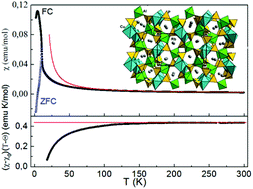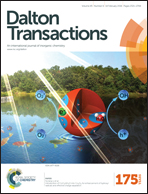An open framework crystal structure and physical properties of RbCuAl(PO4)2†
Abstract
The novel phosphate RbCuAl(PO4)2 was prepared by hydrothermal synthesis at 553 K. Its crystal structure was determined using single-crystal X-ray diffraction data and refined against F2 to R = 0.026. The compound crystallizes in the monoclinic space group P21/c, with unit-cell parameters a = 5.0723(8) Å, b = 14.070(2) Å, c = 9.352(1) Å, β = 100.41(1), V = 656.4(2) Å3, and Z = 4. The crystal structure is based on an open 3D aluminophosphate framework built by AlO5 bipyramids and PO4 tetrahedra sharing oxygen vertices. Channels in the [100] and [001] directions accommodate Rb+ cations and chains of Cu-centered octahedra alternatively sharing cis- and trans-edges. The new phase is characterized by the structure type established for isotypic iron phosphates KMFe(PO4)2, where M = Fe/Ni, Ni, Mg or Co. It also shows topological relationships with Pb2Ni(PO4)2 and Fe3+Fe2+0.5(H2O)2(HPO4)2 structures. The RbCuAl(PO4)2 exhibits rather peculiar physical properties evidenced in specific heat and magnetization measurements. It releases a significant part of magnetic entropy well above the Neel temperature TN = 10.5 K and possesses a spontaneous magnetic moment at lower temperatures. The origin of the spontaneous moment is ascribed to the canting of a pristine antiferromagnetic structure due to the interchain Dzyaloshinskii–Moriya exchange interaction.


 Please wait while we load your content...
Please wait while we load your content...